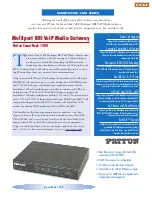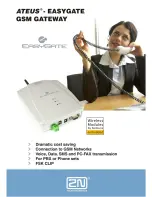
Section 8 DETAILED MENU REFERENCE
124
Receive, if used, must be set to the G.722 mode. The Layer II/III decoder is unable to
accommodate the independent signals.
•
L3 JSTEREO
Layer III Joint Stereo
This selection is best for most stereo program material.
15kHz stereo audio bandwidth is achieved with a 32kHz sample rate. 20kHz stereo
audio bandwidth is achieved with a 48kHz sample rate.
The two audio channels are “tagged,” so that encode channel A appears on the
decoder’s channel A, and encode channel B appears on the decoder’s channel B,
regardless of a swap of the transmission paths.
•
L3 STEREO
Layer III Discrete Channel Stereo
This selection is best for stereo signals with a rich stereo image or when signals are
to be later used in surround- sound applications. It uses two 56/64kbps
transmission channels, such as single ISDN circuit.
15kHz stereo audio bandwidth is achieved with the recommended 32kHz sample
rate. 20kHz stereo audio bandwidth is achieved with a 48kHz sample rate.
The two audio channels are “tagged,” so that encode channel A appears on the
decoder’s channel A, and encode channel B appears on the decoder’s channel B,
regardless of a swap of the transmission paths
•
G.722
G.722 Coding
HOT TIP!
In cases where a return from only one site is required, the
return can be made using LIII Mono. The site which requires
bi-directional audio must connect to Line 1 for this to work.
HOT TIP!
Some older firmware versions of the Zephyr have only one
Layer III stereo mode selection. This mode. labeled STEREO,
is actually Joint Stereo. We had thought everyone would want
to use this mode for stereo. We were wrong, and later added
the ability to choose either of the stereo modes.
DEEP TECH NOTE!
In the JSTEREO and STEREO modes, the two audio
channels are output internally from the coder as a single mixed
bitstream and then split for transmission. At the end of the
process, there is no correspondence between audio channels
and ISDN lines.
Summary of Contents for Zephyr
Page 13: ...Table of Contents 13 SECTION 1 QUICK RESULTS ...
Page 26: ...Section 2 INTRODUCTION 26 This page intentially left blank ...
Page 27: ...Section 2 INTRODUCTION 27 SECTION 2 INTRODUCTION ...
Page 38: ...Section 2 INTRODUCTION 38 This page intentionally left blank ...
Page 39: ...39 SECTION 3 ZEPHYR AT A GLANCE ...
Page 52: ...Section 4 INSTALLATION BASIC OPERATION 52 This page intentionally left blank ...
Page 53: ...Section 4 INSTALLATION BASIC OP 53 SECTION 4 INSTALLATION BASIC OPERATION ...
Page 84: ...Section 4 INSTALLATION BASIC OPERATION 84 ...
Page 85: ...Section 5 ISDN 85 SECTION 5 ISDN ...
Page 105: ...Section 6 NON ISDN NETWORKS 105 SECTION 7 AUDIO CODING ...
Page 118: ...Section 7 AUDIO CODING PRINCIPLES 118 This page intentionally left blank ...
Page 119: ...Section 8 DETAILED MENU REFERENCE 119 SECTION 8 DETAILED MENU REFERENCE ...
Page 157: ...Section 9 REMOTE CONTROL 157 SECTION 9 REMOTE CONTROL ...
Page 176: ...Section 9 REMOTE CONTROL 176 This page intentionally left blank ...
Page 177: ...Section 10 ADVANCED PROBLEM SOLVING 177 SECTION 10 ADVANCED PROBLEM SOLVING ...
Page 196: ...Section 10 ADVANCED PROBLEM SOLVING 196 This page intentionally left blank ...
Page 197: ...Section 11 TECHNICAL INFORMATION 197 SECTION 11 DETAILED TECHNICAL INFORMATION ...
Page 219: ...Section 12 SCHEMATICS 219 SECTION 12 SCHEMATICS ...
Page 221: ...Section 13 MANUFACTURER S DATA SHEETS 221 SECTION 13 MANUFACTURER S DATA SHEETS ...
Page 223: ...Section 14 SPECIFICATIONS WARRANTY 223 SECTION 14 SPECIFICATIONS AND WARRANTY ...
Page 228: ...228 This page intentionally left blank ...
Page 229: ...Section 15 APPENDICES 229 SECTION 15 APPENDICES ...
















































